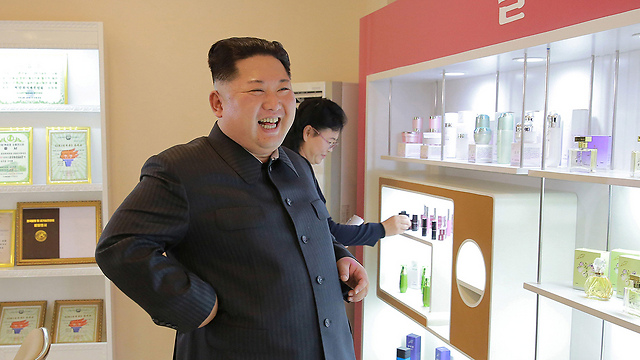

US confirms North Korea fired ballistic missile at Japan
Pentagon estimates missile reached higher than any previous one launched by North Korea; missile is fired a week after US Pres. Trump put North Korea back on list of countries that Washington says support terrorism; targeting Japan allows the US to impose further sanctions.
North Korea launched a missile that landed close to Japan on Tuesday (Wednesday Japanese time). The US Pentagon estimated the missile reached higher to any previous one launched by North Korea.
The Pentagon said its initial assessment was that Pyongyang had tested an intercontinental ballistic missile (ICBM). US President Donald Trump referred to the launch as a situation that will be handled.
North Korea fired the missile a week after Trump put North Korea back on a US list of countries that Washington says support terrorism. The designation allows the United States to impose more sanctions, although some experts said it risked inflaming tensions on the Korean Peninsula.
This is North Korea's first missile launch since it fired a missile over its neighbor in mid-September. Japanese Prime Minister Shinzu Abe convened the country's Security Council in response to North Korea's actions.
Pentagon spokesman Col. Robert Manning said the Pentagon’s initial assessment was an ICBM launched from Sain Ni in North Korea and traveled about 1,000 km before splashing down in the Sea of Japan. The missile did not pose a threat to the United States its territories or allies, the Pentagon said.
Japan’s government estimated that the missile flew for about 50 minutes and landed in the sea in Japan’s exclusive economic zone, Japanese broadcaster NHK said. A North Korean missile on Aug. 29 was airborne for 14 minutes over Japan.
South Korea’s Joint Chiefs of Staff said Wednesday’s missile was fired from Pyongsong, a city in South Pyongan Province, at around 1817 GMT over the sea between South Korea and Japan. The South Korean military said the missile had an altitude of around 4,500 km and flew 960 km.
Minutes after the North fired the missile, South Korea’s military conducted a missile-firing test in response, the South Korean military said.
Japanese Defense Minister Itsunori Onodera said the missile reached an estimated altitude of 4,000 kilometers and broke up before landing in Japan’s exclusive economic zone. He said it was judged to be ICBM class given the missile’s lofted trajectory.
Japanese public broadcaster NHK reported three projectiles were fired, the nearest landing 210 kilometres west of Japan’s northern mainland, suggesting the missile broke into pieces.
Japan’s Kyodo news agency, quoting the defense ministry, said there were no reports of any damage.
The White House said Trump was briefed while the missile was still in the air.
After firing missiles at a rate of about two or three a month since April, North Korea paused its missile launches in late September, after it fired a missile that passed over Japan’s northern Hokkaido island on Sept. 15.
US officials who spoke earlier declined to say what type of missile they thought North Korea might test, but noted that Pyongyang had been working to develop nuclear-tipped missiles capable of hitting the United States and had already tested inter-continental ballistic missiles.
Last week, North Korea denounced Trump’s decision to relist it as a state sponsor of terrorism, calling it a “serious provocation and violent infringement.”
Trump has traded insults and threats with North Korean leader Kim Jong Un and warned in his maiden speech to the United Nations in September that the United States would have no choice but to “totally destroy” North Korea if forced to defend itself or its allies.
Washington has said repeatedly that all options are on the table in dealing with North Korea, including military ones, but that it prefers a peaceful solution by Pyongyang agreeing to give up its nuclear and missile programs.
To this end, Trump has pursued a policy of encouraging countries around the world, including North Korea’s main ally and neighbor, China, to step up sanctions on Pyongyang to persuade it to give up its weapons programs.
North Korea has given no indication it is willing to re-enter dialogue on those terms.
North Korea defends its weapons programs as a necessary defense against US plans to invade. The United States, which has 28,500 troops in South Korea as a legacy of the 1950-53 Korean war, denies any such intention.
Harry Kazianis, director of defense studies at Washington’s conservative Center for the National Interest, said he thought North Korea might hold off on missile testing until about the time of the Winter Olympics, which South Korea is hosting next February, but added that North Korea had to keep testing to refine its weapons program.
“I am surprised, but not shocked,” he said. “North Korea tested two missiles in the fourth quarter last year and will have to continue to test its missile capabilities for years to come if it wants a nuclear deterrent that can hit the US.”

















